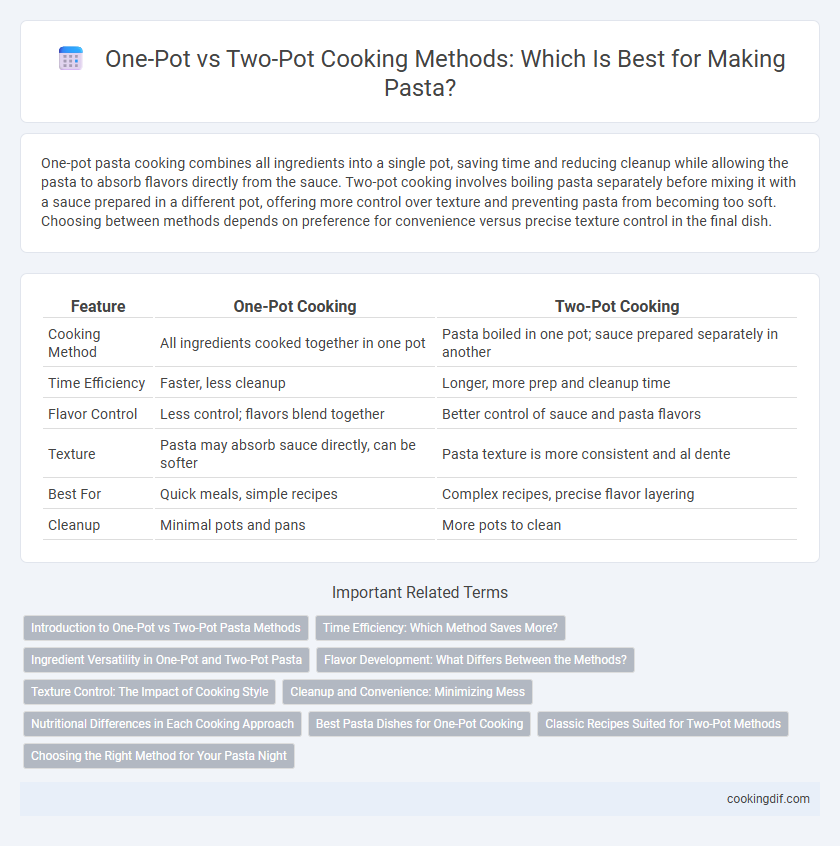One-pot pasta cooking combines all ingredients into a single pot, saving time and reducing cleanup while allowing the pasta to absorb flavors directly from the sauce. Two-pot cooking involves boiling pasta separately before mixing it with a sauce prepared in a different pot, offering more control over texture and preventing pasta from becoming too soft. Choosing between methods depends on preference for convenience versus precise texture control in the final dish.
Table of Comparison
| Feature | One-Pot Cooking | Two-Pot Cooking |
|---|---|---|
| Cooking Method | All ingredients cooked together in one pot | Pasta boiled in one pot; sauce prepared separately in another |
| Time Efficiency | Faster, less cleanup | Longer, more prep and cleanup time |
| Flavor Control | Less control; flavors blend together | Better control of sauce and pasta flavors |
| Texture | Pasta may absorb sauce directly, can be softer | Pasta texture is more consistent and al dente |
| Best For | Quick meals, simple recipes | Complex recipes, precise flavor layering |
| Cleanup | Minimal pots and pans | More pots to clean |
Introduction to One-Pot vs Two-Pot Pasta Methods
One-pot pasta cooking involves combining all ingredients, including pasta, sauce, and seasonings, in a single pot to streamline preparation and reduce cleanup. Two-pot pasta methods separate boiling the pasta from preparing the sauce, offering more control over texture and flavor development but requiring additional cookware. Choosing between these methods depends on time constraints, desired flavor complexity, and kitchen resource availability.
Time Efficiency: Which Method Saves More?
One-pot pasta cooking significantly reduces overall cooking time by combining boiling, simmering, and sauce preparation in a single vessel, allowing flavors to meld while minimizing cleanup. Two-pot methods, while offering greater control over texture and sauce consistency, require separate cooking and transfer stages that extend total preparation time. For time efficiency, one-pot pasta is the preferred method due to its streamlined process and faster meal completion.
Ingredient Versatility in One-Pot and Two-Pot Pasta
One-pot pasta cooking allows for greater ingredient versatility by combining starch, sauce, proteins, and vegetables in a single pot, which enhances flavor integration and reduces cooking time. Two-pot methods provide more control over individual ingredient textures and cooking precision, especially when sauteing proteins or preparing sauces separately before mixing with pasta. Choosing between one-pot and two-pot techniques depends on the desired balance between convenience and culinary control for diverse pasta recipes.
Flavor Development: What Differs Between the Methods?
One-pot pasta cooking enhances flavor development by allowing starches and pasta water to meld directly with sauces, creating a rich, cohesive taste. Two-pot methods separate boiling and sauce preparation, often resulting in less integrated flavors but greater control over sauce consistency. The continuous cooking in a single pot intensifies savory notes, while two-pot techniques can preserve distinct ingredient flavors.
Texture Control: The Impact of Cooking Style
One-pot pasta cooking often yields a softer texture as starches released from the pasta thicken the sauce, creating a creamy consistency. Two-pot methods offer precise texture control by separately boiling pasta to al dente before combining it with sauce, preserving firmness. Chefs seeking specific bite and sauce separation prefer two-pot techniques for optimal texture balance in pasta dishes.
Cleanup and Convenience: Minimizing Mess
One-pot pasta cooking significantly reduces cleanup by combining boiling, sauce preparation, and seasoning in a single pot, minimizing the number of dishes used. This method enhances convenience, especially for busy home cooks, by eliminating the need to manage multiple pots and reducing countertop clutter. In contrast, two-pot cooking often results in more utensils and cookware, increasing both washing time and kitchen mess.
Nutritional Differences in Each Cooking Approach
One-pot pasta cooking retains more water-soluble nutrients like B vitamins and minerals by minimizing nutrient loss during boiling, as the pasta cooks directly in the sauce and water mixture. Two-pot methods often cause leaching of nutrients into the discarded pasta water, reducing the overall nutritional value of the final dish. The one-pot technique also preserves antioxidants from ingredients mixed during cooking, enhancing the nutritional profile compared to separate boiling and sauce preparation.
Best Pasta Dishes for One-Pot Cooking
One-pot pasta dishes excel in simplicity and flavor infusion, combining pasta, sauce, and ingredients in a single pot for quick, hands-off cooking. Favorites like one-pot spaghetti with tomato basil sauce, creamy one-pot mac and cheese, and one-pot cajun chicken Alfredo offer convenience without sacrificing taste. These recipes maximize ingredient absorption and minimize cleanup, making them ideal for busy weeknights and novice cooks.
Classic Recipes Suited for Two-Pot Methods
Classic pasta recipes like Bolognese, carbonara, and alfredo often benefit from two-pot methods to preserve distinct flavors and cooking textures. The first pot is typically used to boil the pasta until al dente, while the second pot is essential for preparing and simmering rich sauces separately. This method ensures optimal sauce consistency and enhances the overall complexity of traditional Italian dishes.
Choosing the Right Method for Your Pasta Night
One-pot pasta recipes streamline cooking by combining pasta, sauce, and ingredients in a single pot, saving time and reducing cleanup while allowing the pasta to absorb rich flavors. Two-pot methods, involving boiling pasta in one pot and preparing sauce separately, offer precise control over texture and sauce consistency, ideal for complex dishes. Selecting between one-pot and two-pot depends on your dinner timing, desired flavor depth, and cleanup preferences for the perfect pasta night experience.
One-pot vs two-pot for cooking method Infographic

 cookingdif.com
cookingdif.com